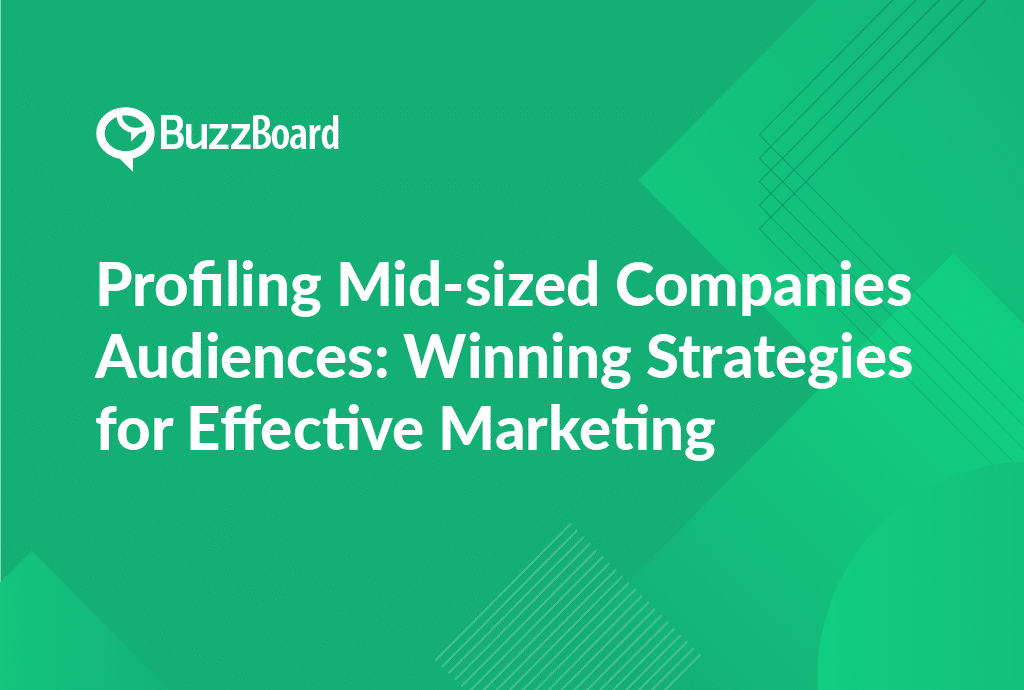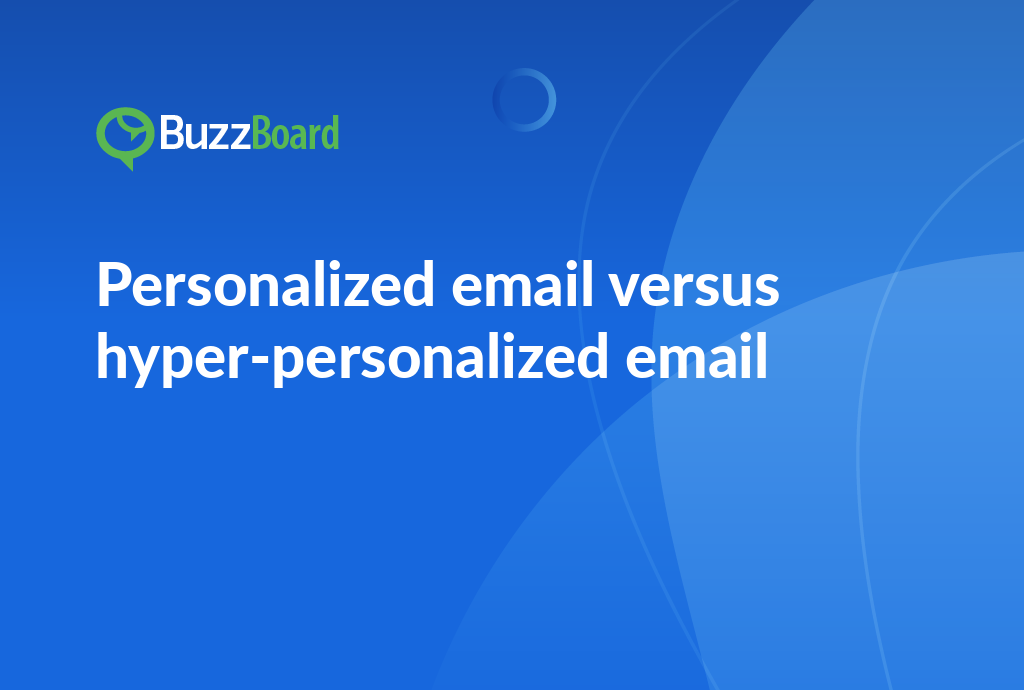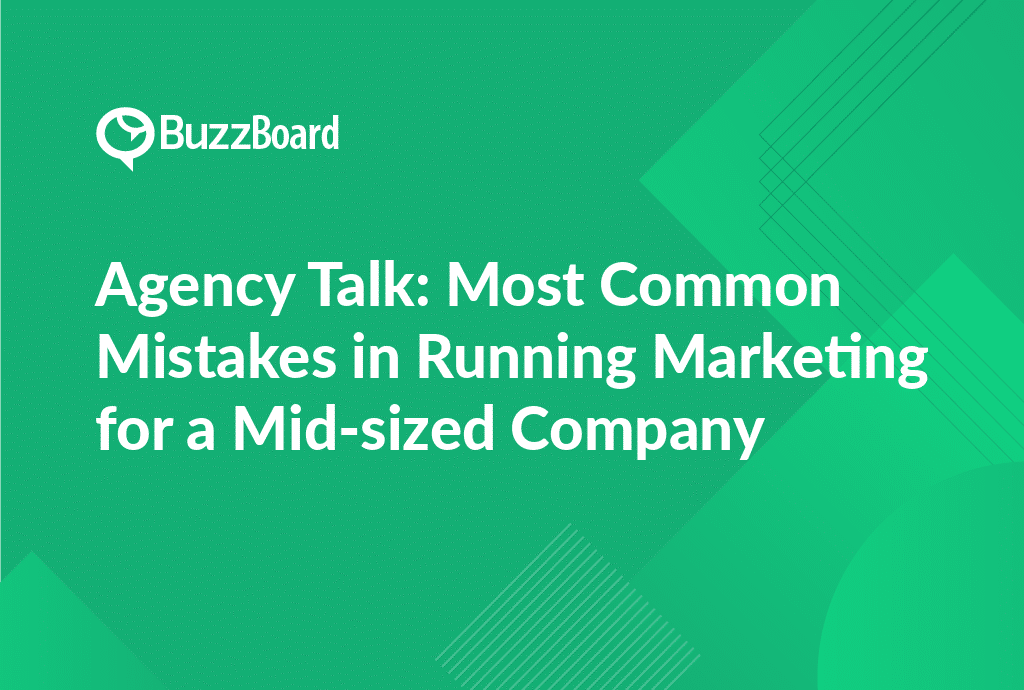What are the winning strategies for effective marketing for mid-sized companies? Profiling mid-sized companies and their audiences reveals that successful marketing strategies focus on building strong relationships, leveraging data-driven insights, and adapting to changing customer needs. Key takeaways include prioritizing customer-centricity, utilizing omnichannel marketing, and measuring ROI to optimize campaigns. By understanding the unique challenges and opportunities of mid-sized companies, marketers can develop targeted strategies that drive growth and success.
Understanding the Importance of Profiling Mid-Sized Companies Audiences for Effective Digital Marketing Strategies
In the constantly changing landscape of digital marketing, understanding your target audience has never been more crucial. There should be no underestimating the importance of profiling mid-sized companies’ audiences as it forms the backbone of effective marketing strategies.
Mid-sized companies encompass a variety of industries, each with its own unique target audience. Digital marketing agencies must consider profiling these companies’ audiences, obtaining comprehensive audience insights to effectively tailor their marketing campaigns.
Profiling involves intensive research to understand the audience’s demographic, their likes and dislikes, interests, and online behaviors. It’s not just about determining who your audience is; it’s about understanding how they interact with the digital world. What kind of content do they consume? Which social networks do they prefer? What are their online behavioral trends?
This profiling extends beyond simple demographics to tap into the consumers’ psychographics. It’s about understanding their motivations, aspirations, and needs. It provides invaluable data that enables marketers to craft personalized and targeted marketing strategies, which significantly boost the chances of conversions.
When it comes to developing effective marketing strategies for mid-sized companies, understanding the target audience is crucial. For instance, let’s consider a mid-sized company that specializes in organic beauty products. The potential target audience for this company would likely be women between the ages of 18 and 40 who prioritize sustainability, stay up-to-date with the latest trends, and prefer online shopping. With this audience insight, a digital marketing agency can construct tailored marketing strategies that cater to their values, interests, and online behavior.
By recognizing the importance of audience profiling, digital marketing agencies can create marketing strategies that are uniquely suited to the needs and preferences of their clients. This approach allows for the creation of customized content that resonates with the target audience, resulting in increased engagement, brand loyalty, and ultimately, conversions.
For example, a digital marketing agency could develop a personalized email marketing campaign that targets women who have shown interest in organic beauty products and sustainability. The campaign could include exclusive promotions, product recommendations, and educational content that speaks directly to the audience’s concerns and interests.
Similarly, targeted social media campaigns could be designed to reach women who are active on platforms such as Instagram and Facebook, where they are likely to engage with content related to beauty, wellness, and sustainability. The agency could create sponsored content, influencer partnerships, and social media ads that speak to the audience’s values and interests, increasing the likelihood of engagement and conversions.
Effective content marketing is another key component of a successful marketing strategy. By creating high-quality, engaging content that addresses the target audience’s needs and concerns, a digital marketing agency can establish the mid-sized company as a thought leader in the industry. This can include blog posts, videos, podcasts, and other forms of content that provide valuable information and insights to the target audience.
Digital marketing agencies that recognize the value of profiling mid-sized companies’ audiences are better positioned to offer unique and compelling marketing strategies. By taking the time to understand the target audience’s values, interests, and online behavior, agencies can create customized content that resonates with the audience, resulting in increased engagement, brand loyalty, and ultimately, conversions. As we move away from the one-size-fits-all era of marketing, it’s essential for digital marketing agencies to stress the importance of audience profiling to their potential clients. By doing so, they can develop marketing strategies that are tailored to the specific needs and preferences of their clients, leading to greater success and ROI.
How Can Digital Marketing Agencies Leverage Audience Insights to Craft Winning Marketing Campaigns for Mid-Sized Companies?
Understanding and leveraging audience insights is a crucial factor in determining the success of a marketing campaign for mid-sized companies. By conducting comprehensive profiling of their target audience, digital marketing agencies can gain valuable insights into the demographic, cultural, and behavioral patterns that drive purchasing decisions. This allows agencies to develop targeted marketing strategies that resonate with their audience and drive measurable results.
However, simply relying on demographic data is no longer sufficient. To truly understand their audience, digital marketing agencies must delve deeper into the psychographics of their target audience, examining their attitudes, interests, and behaviors. This includes understanding their values, motivations, and pain points, as well as their online behaviors and preferences. By doing so, agencies can predict which messages will resonate with their audience, leading to more effective marketing and a higher return on investment.
So, how can these audience insights be utilized to drive marketing success? Primarily, they can be used to shape the creation of user personas, which serve as a guide for designing messaging, campaign themes, and specific ad creative. These personas provide a detailed understanding of the target audience, including their goals, challenges, and behaviors, allowing agencies to tailor their marketing efforts to meet their unique needs and preferences.
In addition to persona development, audience insights can also be used to determine the most suitable channels for reaching the target audience. By understanding which platforms they frequent and trust the most, agencies can optimize their marketing efforts to maximize reach and engagement. For example, if the audience profiling of a mid-sized company reveals that their audience is deeply concerned with environmental conservation, a digital marketing agency can tailor campaigns around sustainable practices or products. The agency can then utilize such campaigns on social platforms popular with environmentally conscious consumers, such as Instagram or Facebook.
Furthermore, advancements in technology have enabled agencies to leverage audience insights for predictive modeling. This allows them to anticipate market trends and customer behaviors even before they manifest, facilitating proactive rather than reactive marketing endeavors. By analyzing large datasets and identifying patterns and correlations, agencies can predict which marketing strategies are likely to be most effective, and optimize their campaigns accordingly.
In addition to predictive modeling, audience insights can also be used to inform content marketing strategies. By understanding the interests and pain points of their target audience, agencies can create content that resonates with them and addresses their specific needs. This can include blog posts, videos, podcasts, and social media content, all of which can be optimized to drive engagement and conversions.
Ultimately, designing an effective marketing campaign is not just about collecting and analyzing data. It’s about interpreting the data and identifying the stories and trends within it. By utilizing audience insights, digital marketing agencies can craft tailored, impactful campaigns that not only resonate with their target audience but also drive measurable results for mid-sized companies. By understanding their audience’s needs, preferences, and behaviors, agencies can develop marketing strategies that are both effective and efficient, and drive long-term growth and success.
Audience insights are a critical component of any successful marketing campaign. By conducting comprehensive profiling of their target audience, digital marketing agencies can gain valuable insights into the demographic, cultural, and behavioral patterns that drive purchasing decisions. By leveraging these insights, agencies can develop targeted marketing strategies that resonate with their audience and drive measurable results. Whether it’s through persona development, predictive modeling, or content marketing, audience insights can be used to drive marketing success and help mid-sized companies achieve their goals.
Profiling Target Audience for Mid-Sized Companies: A Road-Map to Effective Marketing Strategies
Understanding your target audience is more crucial than ever for successful marketing. As a digital marketing agency, profiling mid-sized company audiences can provide invaluable insights, leading to impactful marketing strategies that propel organizations onward. To achieve this, it’s essential to grasp the nature of the mid-sized companies that comprise your target audience.
Mid-sized companies typically employ between 100 and 999 staff, depending on the sector, and face unique challenges. They are often substantial enough to require sophisticated marketing strategies yet might lack the resources of larger corporations. This dichotomy presents a significant opportunity for digital marketing agencies to develop targeted strategies that cater to their specific needs.
The key to marketing effectively to mid-sized companies lies in understanding decision-makers, their pain points, and how your services can address them. Profiling involves a detailed study to glean audience insights that highlight both opportunities and potential pitfalls. This requires a comprehensive approach that encompasses various methods, including:
- Industry reports: Stay up-to-date with the latest trends and developments in your target industry by analyzing industry reports and research studies.
- Intelligence platforms: Leverage insights from reputable intelligence platforms to gain a deeper understanding of your target audience’s behavior, preferences, and pain points.
- Anonymized data from past campaigns: Analyze data from your past campaigns to identify patterns, trends, and areas for improvement.
- Surveys and focus groups: Conduct surveys and focus groups to gather qualitative feedback from your target audience and gain a deeper understanding of their needs and concerns.
By combining these methods, you can create a well-rounded perspective of your target company, highlighting both opportunities and potential pitfalls. This information can then be applied to your digital marketing strategies, enabling you to develop tailored marketing messages grounded in authentic audience insights.
It’s essential to remember that a profile isn’t a one-off task; it needs to be updated regularly to account for market fluctuations and company evolution. As a digital marketing agency, it’s crucial to stay agile and adapt to changing market conditions to ensure your strategies remain effective.
Once you’ve procured this information, you can generate comprehensive profiles of target decision-makers within these mid-sized companies. Highlight their likely business obstacles, their industry, and how your digital marketing services can meet their demands. This will enable you to develop targeted marketing campaigns that resonate with your audience and drive meaningful results.
As a digital marketing agency, devoting time to profiling mid-sized companies comprehensively can lead to a more targeted and effective approach, ultimately benefiting your clients and expanding your business. Uncovering key insights about your target audience isn’t merely part of the job—it’s an investment in the success of your agency and the businesses you represent.
By prioritizing audience profiling, you can:
- Develop targeted marketing campaigns that resonate with your audience
- Increase engagement and conversion rates
- Enhance your agency’s reputation and credibility
- Expand your business by attracting new clients and projects
- Stay ahead of the competition by adapting to changing market conditions
In conclusion, understanding your target audience is crucial for successful marketing in today’s digital landscape. By profiling mid-sized company audiences, you can gain invaluable insights that inform your marketing strategies and drive meaningful results. As a digital marketing agency, it’s essential to prioritize audience profiling to stay ahead of the competition and drive growth for your business.
Why Is Profiling Your Target Audience Crucial for Mid-Sized Companies in Digital Marketing
Understanding your target audience is no longer a nice-to-have, but a must-have for any digital marketing agency working with mid-sized companies. By profiling the audiences of these companies, agencies can create effective marketing strategies that are tailored to the audience’s specific behaviors, needs, and preferences. This targeted approach enables agencies to design more relevant and captivating communications that resonate with their target audience, ultimately driving conversions and revenue.
Studies have consistently shown that companies that employ audience profiling report a significant increase in their conversions, with a staggering 90% of companies experiencing this outcome. This statistic highlights the substantial potential audience profiling offers to digital marketing agencies working with mid-sized companies. By understanding their target audience, agencies can create marketing strategies that are more likely to engage and convert, ultimately driving business results.
Profiling yields vital audience insights that allow digital marketing agencies to identify and comprehend the habits, preferences, and attitudes of their target group. This information enables agencies to design marketing communications that are more relevant and captivating, increasing the likelihood of conversion. For example, if a company’s target audience is mainly millennials, marketers might employ more social media and influencer marketing strategies to reach and engage with this demographic.
Moreover, proficient audience profiling can maximize the return on investment (ROI) of marketing efforts by targeting a specific group and minimizing resources wasted on audiences less likely to convert. By understanding their target audience, agencies can optimize their marketing strategies to focus on the most promising segments, resulting in a higher ROI.
However, audience profiling isn’t a one-time process. The landscape of digital marketing shifts rapidly, with new trends, technologies, and consumer behaviors emerging constantly. Consequently, it’s crucial for digital marketing agencies to regularly refine and adjust the profiles as per evolving market trends and behaviors. This requires ongoing research, analysis, and iteration to ensure that the profiles remain accurate and effective.
When profiling, digital marketing agencies typically consider a range of components, including demographics, psychographics, and customer journey mapping. Demographics refer to the basic characteristics of the target audience, such as age, gender, and location. Psychographics, on the other hand, involve understanding the attitudes, values, and lifestyles of the target audience. Customer journey mapping involves mapping out the customer’s journey, from initial awareness to conversion, to identify pain points and opportunities for improvement.
To gather the necessary data, agencies may use online survey tools, such as Google Forms or SurveyMonkey, or external data providers, such as Experian or Nielsen. They may also conduct interviews, focus groups, or ethnographic research to gain a deeper understanding of their target audience.
In summary, understanding the target audience on a granular level gives digital marketing agencies a competitive advantage. It allows them to devise compelling marketing strategies that resonate, engage, and convert. By profiling their target audience, agencies can create marketing communications that are more relevant and captivating, ultimately driving business results. As the digital marketing landscape continues to evolve, the importance of audience profiling will only continue to grow, making it a crucial component of any successful digital marketing strategy.
Best Practices for Digital Marketing Agencies to Profile and Understand Their Mid-Sized Companies Audiences
digital marketing has become an indispensable tool for companies of all sizes. However, for mid-sized companies, the effective implementation of digital marketing strategies is particularly vital to maintain competitiveness and relevance. One of the most critical components of successful digital marketing is understanding and profiling your target audience. This blog post will provide valuable insights into best practices for accurately understanding and profiling the audiences of mid-sized companies.
To develop a comprehensive understanding of your target audience, it is essential to gather a wide range of information about their needs, preferences, and behavior patterns. This includes demographic and psychographic data, such as age, gender, occupation, interests, values, and lifestyle. Additionally, understanding behavioral patterns, such as online habits, purchasing decisions, and communication preferences, is crucial. Furthermore, identifying the specific needs, preferences, and challenges of your target audience will enable you to tailor your digital marketing strategies to meet their unique requirements.
The more in-depth your understanding of your target audience, the more effective and powerful your marketing strategies will be. For instance, if your target audience primarily consists of older individuals, a marketing strategy that leverages Facebook usage would be more effective due to the high engagement of this demographic on the platform. According to Statista, Facebook is particularly popular among older population segments, making it an ideal platform for reaching this audience.
Moreover, humanizing your digital marketing strategies is vital. At the core of every mid-sized company are individuals with unique needs and preferences. A human-centric approach drives engagement and fosters connections that go beyond mere transactions. By understanding and addressing the individual needs and preferences of your target audience, you can create personalized marketing messages that resonate with them on a deeper level.
Consistency is also a critical component of effective digital marketing. Regular, structured measurement, analysis, and adjustments of your strategies ensure they remain effective. Consistent interaction with your target audience fosters loyalty and engagement, ultimately driving business results. By consistently delivering value to your target audience, you can build trust and credibility, leading to long-term relationships and increased brand loyalty.
To achieve this level of understanding and consistency, it is essential to develop a data-driven approach to marketing. This involves collecting and analyzing data on your target audience’s behavior, preferences, and needs. By leveraging this data, you can identify patterns and trends that inform your marketing strategies and ensure they are aligned with the needs of your target audience.
Understanding and profiling your target audience is a crucial component of effective digital marketing for mid-sized companies. By gathering a wide range of information about their needs, preferences, and behavior patterns, you can develop targeted marketing strategies that resonate with them on a deeper level. Remember, humanizing your digital marketing strategies and consistently delivering value to your target audience are vital components of building trust, credibility, and long-term relationships. By following these best practices, you can develop a comprehensive understanding of your target audience and drive business results through effective digital marketing.
Conclusion
In conclusion, mid-sized companies face unique challenges and opportunities in the marketing landscape. By understanding their target audiences and adapting to changing customer needs, mid-sized companies can develop effective marketing strategies that drive growth and success. Prioritizing customer-centricity, leveraging data-driven insights, and measuring ROI are key to optimizing campaigns and staying ahead of the competition.
By implementing the winning strategies outlined in this article, mid-sized companies can build strong relationships with their customers, increase brand awareness, and drive conversions. Whether it’s through omnichannel marketing, content marketing, or social media marketing, the key is to be flexible, adaptable, and customer-focused.
Ultimately, the most effective marketing strategies for mid-sized companies are those that are tailored to their unique needs and goals. By taking the time to understand their target audiences and adapting to changing market conditions, mid-sized companies can achieve remarkable results and establish themselves as leaders in their industries. By following the winning strategies outlined in this article, mid-sized companies can unlock the full potential of their marketing efforts and achieve long-term success.









